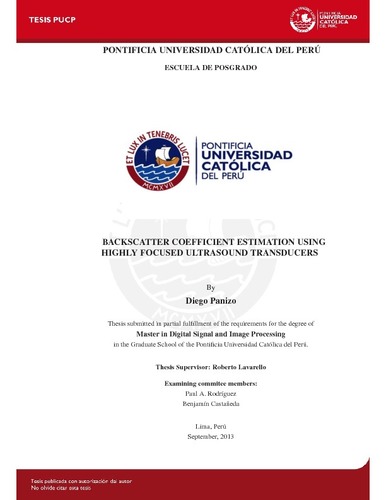| dc.contributor.advisor | Lavarello Montero, Roberto Janniel | |
| dc.contributor.author | Panizo Ríos, Diego | es_ES |
| dc.date.accessioned | 2014-05-26T20:25:20Z | es_ES |
| dc.date.available | 2014-05-26T20:25:20Z | es_ES |
| dc.date.created | 2013 | es_ES |
| dc.date.issued | 2014-05-26 | es_ES |
| dc.identifier.uri | http://hdl.handle.net/20.500.12404/5339 | |
| dc.description.abstract | The backscatter coefficient (BSC) is an intrinsic property that quantifies the amount of energy
that is reflected by a material as function of the ultrasound wave frequency. BSCs have been
proposed for decades for tissue characterization, along with quantitative ultrasound (QUS) parameters
derived from BSCs that have been used to construct images that represent how these
properties vary spatially. The availability of formulations based on weakly focusing conditions
has resulted in a widespread use of large focal number transducers for BSC estimation. The
use of highly focused transducers offers the possibility of improving the spatial resolution of
BSC-based imaging. The model by Chen et al. [1] was developed for estimating BSCs using
transducers of arbitrary focal number. However, to this date only preliminary experimental
validation of this method has been performed.
The goals of the present study are to analyze for the first time the accuracy of Chen’s [1]
method when estimating BSCs using highly focused transducers through both simulations and
experiments, and to analyze the accuracy on the estimation of QUS parameters derived from
BSCs (specifically the effective scatterer size (ESD) and concentration (ESC)) applying the
Chen et al. [1] model.
To achieve these goals, a theoretical model of BSC synthesis based on the method of Chen
et al. [1]. was derived and used with simulated data. The model considers frequency dependent
diffraction patterns, and the scatterers in the synthetic data replicate the properties of solid
spheres. In experiments, data obtained using highly focused transducers from a physical phantom
containing glass beads was used. This experimental data was appropriately compensated
for attenuation and transmission effects. The accuracy of Chen’s method was evaluated calculating
the mean fractional error between the estimated and theoretical BSCs curves for both
simulations and experiments. Also, the QUS parameters were estimated and compared with
real known parameters. BSCs and QUS parameter estimates were obtained from regions of
interest from both the transducer focus and throughout the transducer focal region. Finally, the
sound speed and the transducer focus were varied in appropriate ranges when processing the
data for the BSC and QUS values estimation in order to assess the robustness of the method to
uncertainties in these parameters.
The results showed that BSCs and QUS parameters can be accurately estimated using highly
focused transducers if the appropriate model is used, with regions of interest not restricted to be
centered at the focus but to the full extension of the -6-dB transducer focal region. It was also
verified that well estimated parameters as the sound speed and transducer focus are necessary
in order to obtain accurate BSCs and QUS parameters estimates. | es_ES |
| dc.description.uri | Tesis | es_ES |
| dc.language.iso | eng | es_ES |
| dc.publisher | Pontificia Universidad Católica del Perú | es_ES |
| dc.rights | Atribución 2.5 Perú | * |
| dc.rights | info:eu-repo/semantics/openAccess | es_ES |
| dc.rights.uri | http://creativecommons.org/licenses/by/2.5/pe/ | * |
| dc.subject | Métodos de simulación | es_ES |
| dc.subject | Transductores | es_ES |
| dc.subject | Ultrasonido | es_ES |
| dc.title | Backscatter coefficient estimation using highly focused ultrasound transducers | es_ES |
| dc.type | info:eu-repo/semantics/masterThesis | es_ES |
| thesis.degree.name | Magíster en Procesamiento de señales e imágenes digitales | es_ES |
| thesis.degree.level | Maestría | es_ES |
| thesis.degree.grantor | Pontificia Universidad Católica del Perú. Escuela de Posgrado | es_ES |
| thesis.degree.discipline | Procesamiento de señales e imágenes digitales | es_ES |
| renati.advisor.dni | 10544227 | |
| renati.discipline | 613077 | es_ES |
| renati.level | https://purl.org/pe-repo/renati/level#maestro | es_ES |
| renati.type | http://purl.org/pe-repo/renati/type#tesis | es_ES |
| dc.publisher.country | PE | es_ES |
| dc.subject.ocde | https://purl.org/pe-repo/ocde/ford#2.02.05 | es_ES |






